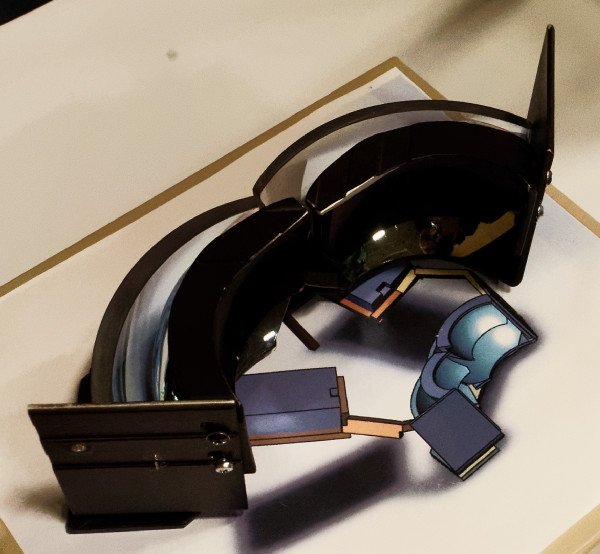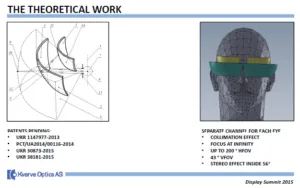Jorn Eriksen is from Kverve, a start up from Norway (Eriksen was the founder of CEO of Projection Design, so has some track record in the industry).
The project that Kverve is working on started with the walkmouse – using an Oculus Rift set of VR viewers and allowing walking. Eriksen said that you quickly lose balance and get nauseous – you need to be supported to use the system. The question is whether you can design a display to support the walkmouse. A wide field of view (FoV) is important so that you don’t have to turn your head when you are using the system.
The inspiration for the Kverve system came from the projection industry. It’s a ‘simulator concept’ with a 200º FOV horizontally and focus at infinity as the image is reflected back from a curved front surface. The FoV is 43º vertical – basically about the same as normal viewing. You can get 110º in each eye with around 50º overlap. Stereo is possible.
The system works by reflecting the imager onto the back of the curved optics and back to the user’s eye. It needs a curved image source, so projection or flexible OLED look like good alternatives.
The concept has been tested as working OK. The VR version uses reflected mirrors while the one for AR is transparent. The imager could be a flexible OLED or picoprojector (talking to the company in the demo area, they suggested that the flexible OLED is a much better option, although for speed of development they used projection).
The concept design uses dual DLP-based pico projectors – but this is “sub-optimal”. Kverve’s IP and interest is in the optics, not so much the imager and the company is looking for interested parties to continue development.
The cost should be cheap for the optics because they can be moulded from plastic and coated. Pico projectors could be used to develop something quickly.
There was a question of how many pixels do you need to fill 200º FoV? FullHD works up to 180°, said Eriksen.
“When will AR/VR arrive?” was another question. Eriksen said that there is lots of work going on to build toolkits and there is lots of investment. There were 23 VR companies at E3 and more than 20 have series A funding at $20 million in Silicon Valley.
Consumer VR systems should appear in Q1 2016. The content development difference between AR/VR is basically very small. It all helps drive the overall ecosystem. VR investment will add momentum to AR, but he believes that AR will be a couple of years behind VR.
AR may need some new application to drive consumer demand as well as simply being “cool”.
Light output of around 10 – 30 lumens may be needed to make the Kverve system work and Eriksen said that the Ostendo type of microLED is interesting. For avionics applications, which are also possible, more power/brightness is needed.


